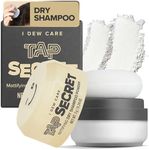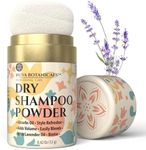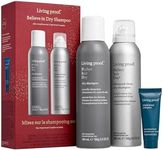Buying Guide for the Best Dry Shampoos
Choosing the right dry shampoo can make a big difference in how your hair looks and feels between washes. Dry shampoos are designed to absorb excess oil, refresh your scalp, and add volume without the need for water. When picking a dry shampoo, it's important to consider your hair type, scalp sensitivity, and the look you want to achieve. Understanding the key features will help you find a product that fits your needs and keeps your hair looking its best.Hair Type CompatibilityHair type compatibility refers to how well a dry shampoo works with different hair textures, such as fine, thick, curly, or straight hair. This is important because some formulas are designed to add volume for fine hair, while others may be more moisturizing for thick or curly hair. To navigate this, look for products labeled for your specific hair type. If you have fine hair, choose lightweight formulas that won't weigh your hair down. For thick or curly hair, opt for nourishing or hydrating options. Picking a dry shampoo that matches your hair type ensures better results and avoids unwanted residue or dryness.
Residue and FinishResidue and finish describe how much visible powder or texture the dry shampoo leaves on your hair after application. This is important because some dry shampoos can leave a white or chalky residue, especially on dark hair. Products can range from invisible formulas to those that add a matte or textured finish. If you have dark hair, look for clear or tinted options to avoid white marks. If you want extra volume or texture, a matte finish might be ideal. Consider your hair color and the style you want when choosing the right finish for you.
ScentScent refers to the fragrance added to the dry shampoo, which can range from light and fresh to strong and perfumed. This is important because the scent will linger in your hair throughout the day. If you are sensitive to fragrances or prefer a subtle smell, choose unscented or lightly scented options. If you enjoy a noticeable fragrance, there are many choices with floral, fruity, or clean scents. Your personal preference and any sensitivities should guide your choice here.
Oil Absorption StrengthOil absorption strength indicates how effectively the dry shampoo can soak up excess oil from your scalp and hair. This is crucial for people with oily hair or those who go several days between washes. Some dry shampoos are designed for light refreshment, while others are more powerful for heavy oil control. If your hair gets oily quickly, look for strong oil-absorbing formulas. If you just need a light touch-up, a milder product will do. Think about how oily your hair gets and how often you plan to use the product to find the right level of oil absorption.
Application MethodApplication method refers to how the dry shampoo is dispensed, such as aerosol spray, powder, or foam. This matters because each method offers a different experience and result. Aerosol sprays are quick and easy to use, providing even coverage. Powders can be more precise and are often preferred for travel or sensitive scalps. Foams are lightweight and can be worked into the hair more like a traditional shampoo. Consider your routine and comfort level—if you want speed and convenience, sprays are great; if you prefer control or have a sensitive scalp, powders or foams might be better.
















